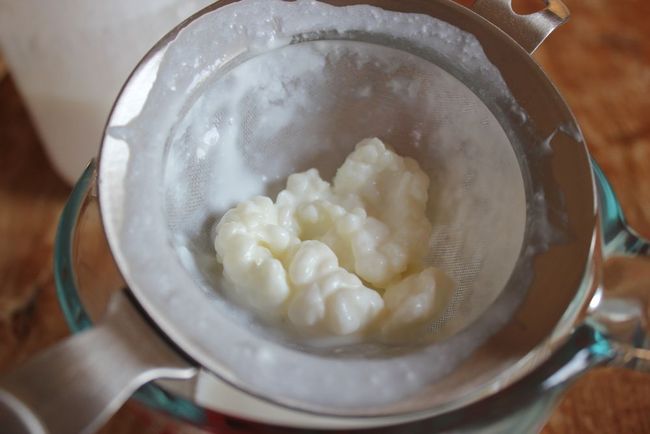I have an exciting new kitchen witchery experiment going! As of the day before Thanksgiving, there has been a nook on the shelf of our hutch in the kitchen dedicated to this: Noooo - it's not a candle... it's kefir! Kefir is a fermented milk drink, similar to yogurt with origins in Eastern Europe. The traditional "starter" is a living colony/symbiotic culture of yeasts and lactic bacteria that resembles cauliflower or little opaque beads clumped together. These "beads" are commonly referred to as grains, and they will actually grow in number daily as they consume and ferment more and more lactose while fermenting milk into a super-powered probiotic drink.
Noooo - it's not a candle... it's kefir! Kefir is a fermented milk drink, similar to yogurt with origins in Eastern Europe. The traditional "starter" is a living colony/symbiotic culture of yeasts and lactic bacteria that resembles cauliflower or little opaque beads clumped together. These "beads" are commonly referred to as grains, and they will actually grow in number daily as they consume and ferment more and more lactose while fermenting milk into a super-powered probiotic drink.
Before this experiment, I had never consumed traditional kefir. I had tried the kind you can buy in the grocery store and made my own with freeze dried cultures... These are just approximations of the real thing, they use a cocktail of isolated commercial cultures and yeasts to create something similar, and in our previous life (in the city) they were an easy starting point and seemed to be much more convenient options than babying a living colony.
Why go through the hassle to procure live kefir grains and "feed" them daily? As a previously super-active traveler, I seriously respect the power of "good gut bugs". When a cold, virus, weird water, or stress, starts to chip away at my health, I've always found probiotics to be extremely helpful. Good yogurt might have up to 6 strains of beneficial bacteria, dried/powdered kefir starters contain, on average, less than 10 strains of beneficial yeast and bacteria. Kefir grains contain close to 30. The fermented drink is rich in B vitamins as well. While my traveling is now limited to the far corner of the pastures and back, I rely on my health more than ever. You can't call out sick on the farm. I don't think the goats would be very understanding if I stayed in bed for the morning milking to nurse a cold!
As added incentive, the grains will last forever if treated with care, as opposed to 2 batches with freeze dried cultures. Not only will they keep working as long as you remember to feed them, as I mentioned earlier, they will also multiply - you can give the extra cultures to a friend or eat them for an extra boost.
A few months ago, my friend Bobbi asked if I'd like to go in with her on an order of the real thing. We finally got around to placing our order and a week later, the grains were here. I started the batch and by day four had enough to split into two colonies.
So - starting yesterday, I've had a delicious glass of kefir each morning before heading out to round up the goats. I say yesterday (although I've had the grains for almost two weeks) because it took me about a week to get my little colony up to speed. This might have taken less time if I had started with less milk. The farm I ordered from sent about 3 Tbs of live kefir grains that had been growing in goat's milk. The instructions said to add 1-3 cups of milk to the grains and change each 24 hours - or as needed. I added almost 2 cups of our fresh raw goat's milk and strained it about 24 hours later. What I had on my hands wasn't exactly something to rave about.
My Grandpa was here and I convinced him to try to the first batch with me. By itself it was thin and had a very strong bitter/funk to it that reminded my Grandpa of rye bread. I blended it up with some ice, berries, and honey. It was gross. But not disgusting, so I drank it. Grandpa drank his too, but only finishing after doctoring with a bit of maple syrup. Bleh. But then, that day, I felt GREAT. I can't explain it, but I felt good and decided the next morning, when faced with a similarly nasty kefir, that it was worth holding my breath to drink. So I did this for several days, adding a little less milk each time because the texture was still too thin.
It took a little tweaking, but I finally have something to rave about! For the past several days, the kefir has been delicious - creamy and tart with a little effervescent zing to it. I've read that you can use it in all sorts of culinary, from baking to cheesemaking. Have you tried anything of the sort?
